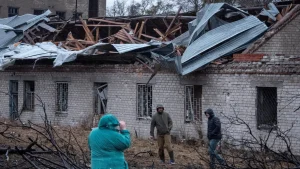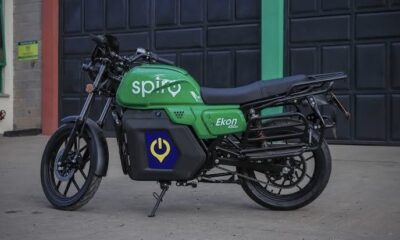News
Russia’s Oreshnik Missile: What We Know
Putin said that the weapon travelled at a speed of Mach 10, or 2.5-3km per second (10 times the speed of sound), adding that “there are currently no ways of counteracting this weapon”.

BBC—On Thursday, the Ukrainian city of Dnipro was hit by a Russian air strike which eyewitnesses described as unusual, triggering explosions that went on for three hours.
The attack included a strike by a missile so powerful that in the aftermath Ukrainian officials said it bore the characteristics of an intercontinental ballistic missile (ICBM).
Western officials were quick to deny this, saying that such a strike would have triggered a nuclear alert in the US.
Hours after the strike, Russian President Vladimir Putin, in a TV address, said that Russia had launched a “new conventional intermediate-range” missile with the codename Oreshnik, meaning hazel tree in Russian.
Putin said that the weapon travelled at a speed of Mach 10, or 2.5-3km per second (10 times the speed of sound), adding that “there are currently no ways of counteracting this weapon”.
He said that a major military-industrial site in Dnipro, used to manufacture missiles and other armaments, had been hit. He described the attack as a test which was “successful” because the “target was reached”.
Speaking a day later to senior defence officials, he said tests of the missile would continue, “including in combat conditions”.
Putin’s description of the weapon notwithstanding, there seems to be no clear consensus about what it actually is.
Ukrainian military intelligence maintains that the missile is a new type of ICBM known as Kedr (cedar). They say it was travelling at Mach 11 and took 15 minutes to arrive from the launch site, more than 1,000km (621,370 miles) away in the Astrakhan region of Russia.
They said the missile was equipped with six warheads, each with six sub-munitions.
This assumption is backed up by BBC Verify’s examination of video footage of the strike. Most of it is blurry or of poor quality, but it clearly shows six flashes against the night sky, each comprised of a cluster of six individual projectiles.
The location that was hit is an industrial area to the southwest of Dnipro city.

Damage caused by Thursday’s attack on Dnipro, carried out by the Oreshnik in combination with other missiles
Why is speed important?
If Putin’s description is correct, the missile is at the upper edge of the definition of hypersonic, and few things can achieve this.
Speed is important because the faster a missile travels, the quicker it gets to target. The quicker it gets to target, the less time a defending military has to react.
A ballistic missile generally gets to target by following an arcing path up into the atmosphere and a similar one down towards its destination.
But as it descends, it picks up speed and gains kinetic energy, and more kinetic energy gives it more options. This allows it to manoeuvre down towards the target – by performing some kind of defending wriggle – that makes interception by surface-to-air missile systems (such as Ukraine’s US-built Patriot defence missile system) particularly difficult.
This is not new for militaries that have to defend against such threats of course, but the greater the speed, the harder it becomes.
That is why Putin has likely placed emphasis on its speed in announcing this new type of missile.
Some 80% of the missiles fired by Russia have been intercepted by Ukraine, an extraordinary figure. But these faster speeds of ballistic missiles are intended to try to bring that percentage down.
What is the new missile’s range?
Russian military expert Ilya Kramnik told the newspaper Izvestiya it is likely that the new missile, whose development has been classified until now, is at the upper end of medium-range missiles.
‘It is likely that we are dealing with a new generation of Russian intermediate-range missiles [with a range of] 2,500-3,000km [1,550-1,860 miles] and potentially extending to 5,000km [3,100 miles], but not intercontinental,” he says.
This could put almost the whole of Europe within range, but not the US.
“It is obviously equipped with a separating warhead with individual guidance units,” Kramnik added.
He suggested that it could be a reduced version of the Yars-M missile complex, which is an ICBM.
Russia was reported to have started production of a new version of this missile complex last year which included much more mobile independent warheads.
Another expert, Dmitry Kornev, told the paper the Oreshnik could have been created on the basis of the shorter-range Iskander missiles – already commonly used on Ukraine – but with a new-generation engine.
An Iskander with an enlarged engine was used at the Kapustin Yar test site in southern Russia last spring, he said, adding that this may well have been the Oreshnik. Thursday’s missile was fired into Ukraine from the same site.
How effective could it be?
Military analyst Vladislav Shurygin told Izvestiya that the Oreshnik was capable of overcoming any existing modern missile defence systems.
It could also destroy well-protected bunkers at great depths without using a nuclear warhead, he said, although there is no evidence of underground facilities being destroyed at the Dnipro plant.
Another Russian analyst, Igor Korotchenko, told Tass news agency the missile had multiple independently guided warheads, adding that the “practically simultaneous arrival of the warheads at the target” was extremely effective.
Justin Crump, CEO and founder of the risk advisory company Sibylline, told BBC Verify that the missile had the capacity to seriously challenge Ukraine’s air defences.
“Russia’s short range ballistic missiles have been one of the more potent threats to Ukraine in this conflict,” he said. “Faster, more advanced systems would increase that an order of magnitude.”
Kenya Insights allows guest blogging, if you want to be published on Kenya’s most authoritative and accurate blog, have an expose, news TIPS, story angles, human interest stories, drop us an email on [email protected] or via Telegram
-

 Business2 weeks ago
Business2 weeks agoIt’s a Carbon Trading Firm: What Kenyans Need to Know About Spiro’s Business Model Amid Damning Allegations of Predatory Lending
-

 Business2 weeks ago
Business2 weeks agoManager Flees Safaricom-Linked Sacco As Fears Of Investors Losing Savings Becomes Imminent
-

 News2 weeks ago
News2 weeks agoWoman Accused in High Defamation Blames AI As Case Exposes How Mombasa Billionaire Mohamed Jaffer Allegedly Sponsored Smear Campaign Linking Joho’s Family To Drug Trafficking
-

 Investigations5 days ago
Investigations5 days agoBillions Stolen, Millions Laundered: How Minnesota’s COVID Fraud Exposed Cracks in Somali Remittance Networks
-

 News6 days ago
News6 days agoUS Moves to Seize Luxury Kenya Properties in Sh39 Billion Covid Fraud Scandal
-

 Investigations2 weeks ago
Investigations2 weeks agoIntelligence Report Links Budding Politician James Mabele Magio To International Scammers Ring
-

 Investigations5 days ago
Investigations5 days agoJulius Mwale Throws Contractor Under the Bus in Court Amid Mounting Pressure From Indebted Partners
-

 News6 days ago
News6 days agoMAINGA CLINGS TO POWER: Kenya Railways Boss Defies Tenure Expiry Amid Corruption Storm and Court Battles


















